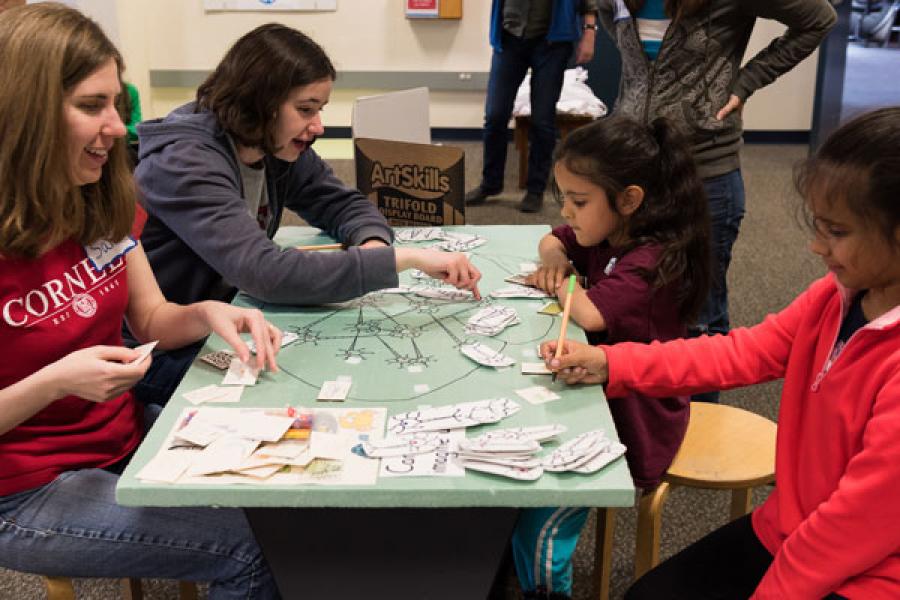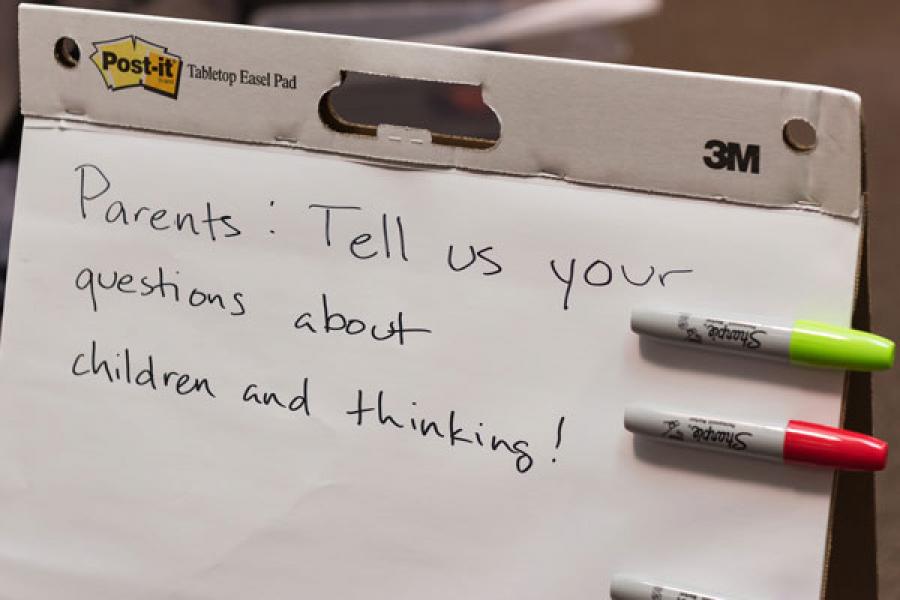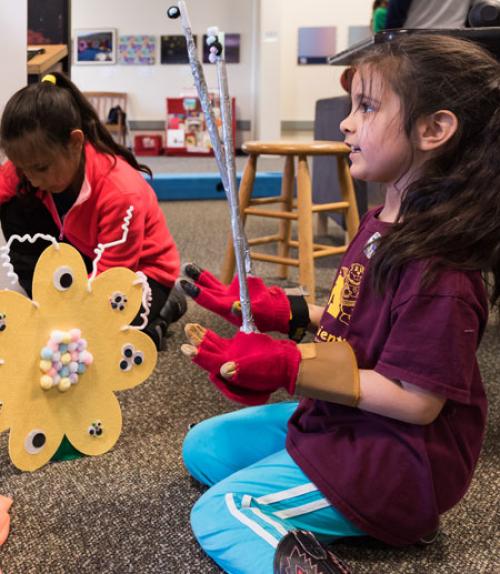When the 11 students in PSYCH 4500, Psychology at the Sciencenter!, first walked into their classroom, instead of chairs they found a “maker” space: walls lined with shelves of crafts supplies like glue, string, foam board, nails, marbles, and the ever-versatile duct tape.
Their first assignment: create a science demo based on a simple description.
In groups, the students constructed a hot air balloon, a roller coaster, a windmill, and more. And while creating the demos was a challenge, recalled doctoral student Samantha Carouso Peck, “it paled in comparison to the next task: to write a clear description for a demo ourselves, when we were provided only with a scientific concept we needed to convey.” Her group’s topic was transfer of energy through a fluid medium. Their solution was an activity that asked participants to construct a vessel and find two different techniques to propel it across a tub of water without using their hands.
“This is by far the most rewarding and challenging course I’ve ever taught,” said Michael Goldstein, associate professor of psychology. His usual research focuses on the evolution and development of vocal learning in birds and babies, and learning about science communication was a whole new field, both for him and Assistant Professor of Psychology Khena Swallow, whose research focuses on attention and memory in adults.
The idea for the class arose when Swallow noticed the lack of psychology or neuroscience exhibits at the Sciencenter. It turns out that nationally -- and internationally -- cognitive science exhibits are rare, especially interactive ones.
The course goal is to produce one or two polished exhibit ideas that the Sciencenter can actually use. Since Goldstein and Swallow plan to offer the class on an ongoing basis – it will be a 2017-18 University Course – after four or five years they hope to have a suite of exhibits developed about psychological science.
“What we got through this class is great. We wanted our audience to learn about psychology, what scientists know about how people learn and develop, and our audience definitely got that,” said Michelle Kortenaar, Senior Director of Engagement and Learning at the Sciencenter. Some of the students’ prototypes could be converted into stand-alone exhibits, or used as facilitated exhibits, she added.
Graduate students Samantha Peck, front left, and Caitlyn Finton work with Thora Iyer and Ada Iyer on the Imagine That! exhibit at the Sciencenter in Ithaca.
Sciencenter staff provided guidance in how to develop an exhibit that considers the interests of the audience and how to evaluate an exhibit’s effectiveness, working with the students during and outside of class. In addition to the Sciencenter partners, Bruce Lewenstein, specialist in science communication and chair of the Department of Science and Technology Studies, served in an advisory role.
The course was supported by an Engaged Cornell grant which enabled Goldstein and Swallow to visit numerous science and children’s museums to learn best practices; the grant also helped support the Sciencenter’s contributions to the course.
“A lot of science communication is about how to give a good talk. But how do you know the public got anything?” said Goldstein. “We wanted to get beyond answering the ‘so what?’ question and package research in an exhibit that lets us know if we got the message across. An exhibit lets everybody be active and scientists become learners really fast. ”
Creating an exhibit
The students’ course challenge was to create interactive exhibits that allow children to experiment, analyze and think independently.
“I was surprised at how hard it actually is to create a functional science exhibit that successfully engages audiences,” said class participant Caitlyn Finton, a doctoral student.
One of the designs, “Hungry Hungry Aliens,” demonstrated embodied cognition – that changing your body changes how you think about the world. Participants wore gloves that turned their hands into different types of alien hands, which they could use to catch food in different environments. By switching gloves, children learned that cognition changes when your body or environment change.
Graduate student Melissa Elston works with Thora Iyer using the Hungry Aliens exhibit at the Sciencenter.
“Early prototypes made of pipe cleaners and thumb tacks turned into increasingly refined designs, largely thanks to our helpful beta testers -- the children of the Sciencenter and Bright Horizons daycare -- who showed us the strengths and weaknesses of our prototypes through every step of development,” Said Samantha Peck, a graduate student in the seminar.
The final polished exhibit on neural circuitry, “Imagine That!,” is designed to show how the brain imagines concepts. To build the concept of an animal, participants connect “neurons” between different characteristics, such as “four-legged,” “scales,” and “tail.” The network thus created represents the animal. Participants can then change the neural network – and the concept – by connecting different characteristics than before, so that a four-legged dog with a tail becomes a legless snake with scales.
“The exhibit shows that you can change the concept of a zebra into the concept of a dog by changing the connectivity of neural networks,” Goldstein explained. “It’s simplistic but elegant. And it works.”
“Rarely does a class focus on creativity and construction as its primary daily requirements, and even more rarely does classwork for a course ultimately result not merely in a stack of papers which will never be read again, but in a physical, hand-built exhibit which can be enjoyed by children at the Sciencenter,” said Peck.
Prototyping is important, since a permanent exhibit at the Sciencenter typically costs about $25,000. The prototypes are built from foam board and duct tape, which enables the students to modify them as needed. “Designing these prototypes has been a great demonstration of how being frustrated and working it through is really valuable,” said Goldstein. “One of the values to students of this class is they’re not making a perfect exhibit right off the bat, or ever. It’s an iteration: see what didn’t work and go back and fix it.”
Swallow said that the biggest challenge in designing exhibits was how to convey information with some amount of authority while also allowing information to be wrong and incomplete. The professors wanted to convey not just findings but also the methods that non-scientists rarely see. “The exhibits we developed help dispel myths about what psychology is, displaying it as an academic discipline with its own set of scientific techniques,” said Swallow.
Testing the prototypes
After developing the prototypes, the students brought them to the Sciencenter to test. While children interacted with the exhibit prototypes, the adults accompanying them had the opportunity to talk with the Cornell students.
“We got the extra benefit that our audience was interacting with real scientists, so they could see what they looked like and what they did and have conversations with them about science,” said Kortenaar. “The scientists became part of the exhibit.”
For Sarah Dincin ’19, that town-gown connection was critical. “The most important thing I discovered this semester is how much we as students/Cornellians can learn from members of the Ithaca community,” she said. “It has been incredible to be able to communicate directly with children and their parents at the Sciencenter, and their feedback was instrumental in our prototype design process.”
Some of that feedback came from a whiteboard the students put up at the Sciencenter to solicit questions from parents. The questions were wide ranging, like how do allergies develop and whether bilingualism is important. What was unexpected, said Kortenaar, was that “our visitors started answering each other’s questions and it ended up being a handwritten blog on the wall.”
Prototype of white board, initially used at Sciencenter.
“It can be easy for scientists to fall into the trap of believing that if we show the public enough facts, they will believe us,” said Finton. “This course taught me that in actuality, I will have better success in communicating science if I take into account the opinions and beliefs of the group with which I am communicating.”
Swallow said that the students’ remarkable ideas and creativity exceeded her and Goldstein’s expectations when they began the course. The students’ successful efforts have already generated interest beyond the Sciencenter: Goldstein and Swallow have been contacted by area preschools as well as the New York State Fair.
A version of this story appeared in the Cornell Chronicle.







